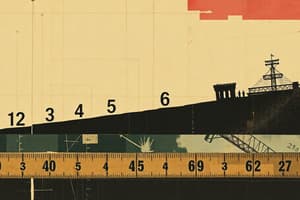Podcast
Questions and Answers
What represents the zero point on a number line?
What represents the zero point on a number line?
- The rightmost point on the line
- The point where positive and negative values meet
- The leftmost point on the line
- The center point that separates positive and negative numbers (correct)
Which statement accurately describes the movement on a number line when adding a negative number?
Which statement accurately describes the movement on a number line when adding a negative number?
- It moves to the left (correct)
- It stays at the same position
- It oscillates between left and right
- It moves to the right
How is distance between two points on a number line calculated?
How is distance between two points on a number line calculated?
- By adding their absolute values
- By finding the sum of the two numbers
- By taking the absolute value of their difference (correct)
- By subtracting the larger number from the smaller number
Which of the following correctly identifies a number that is less than -2 on the number line?
Which of the following correctly identifies a number that is less than -2 on the number line?
What happens when a positive number is subtracted from another positive number on a number line?
What happens when a positive number is subtracted from another positive number on a number line?
Flashcards are hidden until you start studying
Study Notes
Number Line Concepts
-
Definition: A number line is a straight line that represents numbers as points at equal intervals. It extends infinitely in both directions.
-
Components:
- Zero Point: The center of the number line; separates positive and negative numbers.
- Positive Numbers: Located to the right of zero; represent values greater than zero (e.g., 1, 2, 3).
- Negative Numbers: Located to the left of zero; represent values less than zero (e.g., -1, -2, -3).
-
Direction:
- Moving right on the number line indicates increasing values (positive direction).
- Moving left indicates decreasing values (negative direction).
-
Distance:
- The distance between two points on a number line is the absolute value of their difference (e.g., the distance between -3 and 2 is |2 - (-3)| = 5).
-
Comparisons:
- A number is greater than another if it is farther to the right on the number line (e.g., 3 > 0, -1 > -3).
- A number is less than another if it is farther to the left (e.g., -4 < -2, 0 < 1).
-
Addition and Subtraction:
- Adding a positive number moves right on the number line.
- Adding a negative number (subtracting) moves left on the number line.
- Subtracting a positive number moves left, while subtracting a negative number (adding) moves right.
-
Visual Representation:
- Number lines can be used to visualize operations involving positive and negative numbers, helping to understand their relationships and effects.
-
Applications:
- Number lines are used in various mathematical concepts, including arithmetic, algebra, and graphing functions.
Number Line Concepts
- A number line is a visual representation of numbers arranged in a straight line, extending infinitely in both positive and negative directions.
- Zero Point: Acts as the central reference point, dividing the number line into positive numbers (right) and negative numbers (left).
- Positive Numbers: Found on the right side of zero; examples include 1, 2, and 3, representing values greater than zero.
- Negative Numbers: Positioned on the left side of zero; examples such as -1, -2, and -3 represent values less than zero.
- Directionality:
- Movement to the right signifies increasing values (positive direction).
- Movement to the left indicates decreasing values (negative direction).
- Distance Measurement: The distance between any two points is determined by the absolute value of the difference between them; e.g., the distance from -3 to 2 is five units.
- Comparative Analysis:
- A number to the right is greater than one to the left (e.g., 3 is greater than 0, -1 is greater than -3).
- Conversely, a number to the left is less than one to the right (e.g., -4 is less than -2, 0 is less than 1).
- Operations:
- Adding a positive number results in a rightward movement on the number line.
- Adding a negative number (which is effectively subtraction) results in a leftward movement.
- Subtracting a positive number moves left, while subtracting a negative number (which is effectively addition) results in a rightward movement.
- Visual Representation: Number lines help to visualize the relationships between numbers and operations involving both positive and negative numbers.
- Mathematical Applications: Essential in various areas of mathematics, including basic arithmetic, algebra, and graphing of functions, offering a foundational understanding of numerical relationships.
Studying That Suits You
Use AI to generate personalized quizzes and flashcards to suit your learning preferences.




